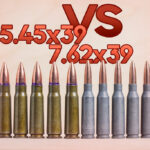
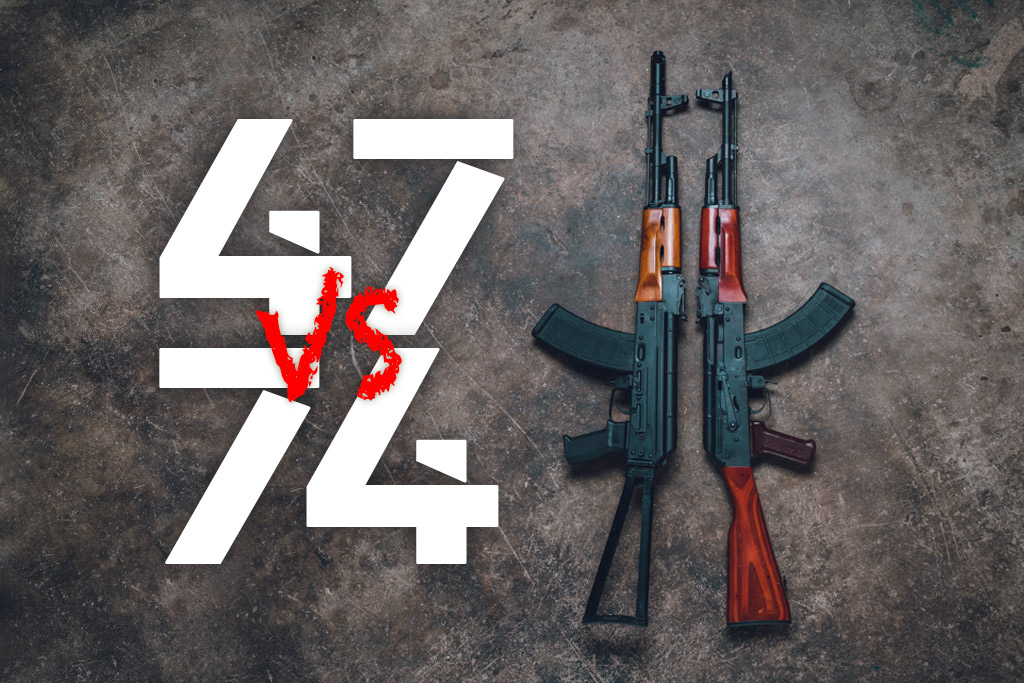
By Guy J. Sagi
Mikhail Kalashnikov is an indelible name in firearm history. In fact, he’s the reason we have the AK-47 VS AK-74 argument to consider. He designed the 7.62x39mm-chambered AK-47, the Avtomat Kalashnikov – loosely translated as Automatic Kalashnikov – that the Soviet Union officially adopted in 1947. Decades later, he supervised the group led by Alexei D. Kryakushin that improved it. The Soviet Union drafted the results of that effort, the AK-74, into service in 1974.
The AK-74 shares the gas-operated, rotating-bolt system of operation and many parts with its predecessor. There are a few significant upgrades, however. Most notably, it’s chambered in 5.45x39mm, a smaller, higher-velocity cartridge that improves effective distance and allows the military to harness the logistical advantages of its reduced weight and size. Upgrades to the extraction system also make most consider the AK-74 the more reliable of the pair.
We’ll take a look at the guns and the man behind them to help explain why his innovative design carries those virtues, and its latest iteration continues that tradition.
AK-47 VS AK-74: An Overview
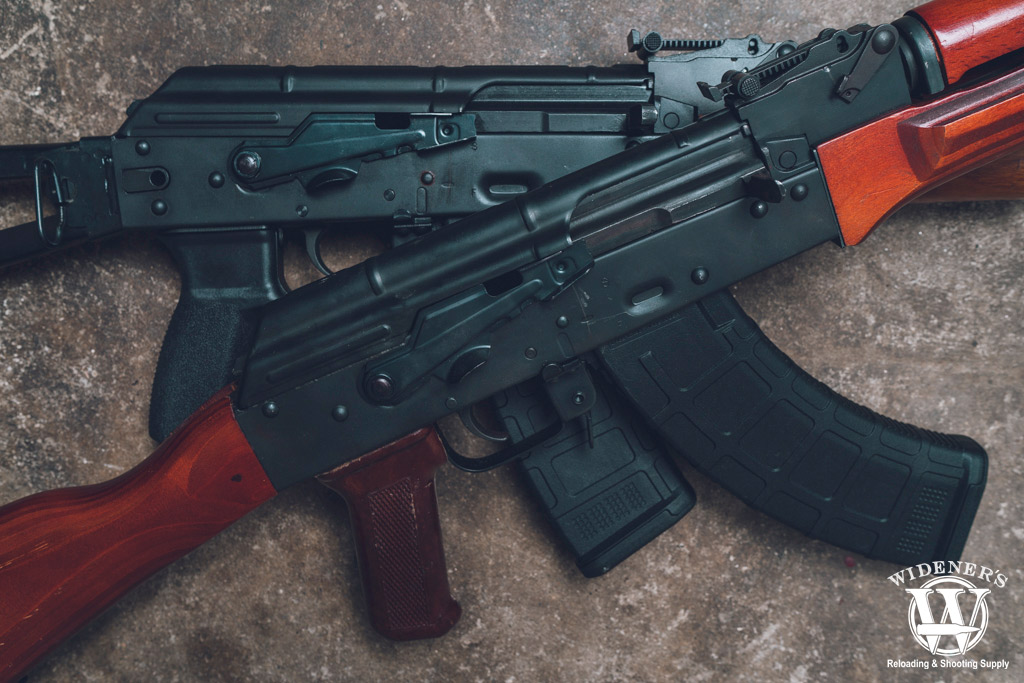
Which one is which? Identifying the AK-47 VS AK-74 may require you to read the stamp on the receiver.
There’s plenty to discuss when comparing the AK-47 VS AK-74. From the outside, they look very similar, in fact, they are often confused as being the same gun. If you have them side-by-side, you may want to double-check the stamp on the receiver before attempting to load them. There are several key differences between them that I’ll point out, including their intended purposes on the battlefield.
Both rifles are similar in size and weight, and their capacities are equal (depending on the magazine inserted). The AK-74 weighs less due to its new stock, redesigned gas block, polymer magazines, and caliber chambering. If you’re holding both rifles, you’ll also notice the spring washer on the back of the AK-74’s gas tube. This helps hold it in place more securely during operation, as the rifle is rated to fire 100 rounds per minute in full auto mode.
The AK-47 remains a popular small arms battle rifle. It’s the rifle that arguably changed the nature of war, giving guerrillas and insurgents an equalizer. The AK-74 replaced it as the standard Soviet infantry rifle, in the same way, the M16 replaced the M14 for the US. Its appearance (on both sides) in the Russia-Ukraine war tells you everything you need to know about its deadly abilities. Modernized versions of the 74 are highly desired in combat zones, even being sought after by our own military.
| Rifle | In Service | Caliber | Effective Range | Capacity | Barrel Length | Overall Length | Weight Un/Loaded |
|---|---|---|---|---|---|---|---|
| AK-47 | 1949-1974 | 7.62×39 | 380 Yards | 20/30 Round Magazines | 16.3″ | 35.5″ | 7.7/9.7 Lbs |
| AK-74 | 1974-Present | 5.45×39 | 550 Yards | 30 Round Magazine | 16.3″ | 37.1″ | 6.8/8.2 Lbs |
Before we go any further, let’s take a look at AK-47 VS AK-74 ballistics.
5.45×39 VS 7.62×39
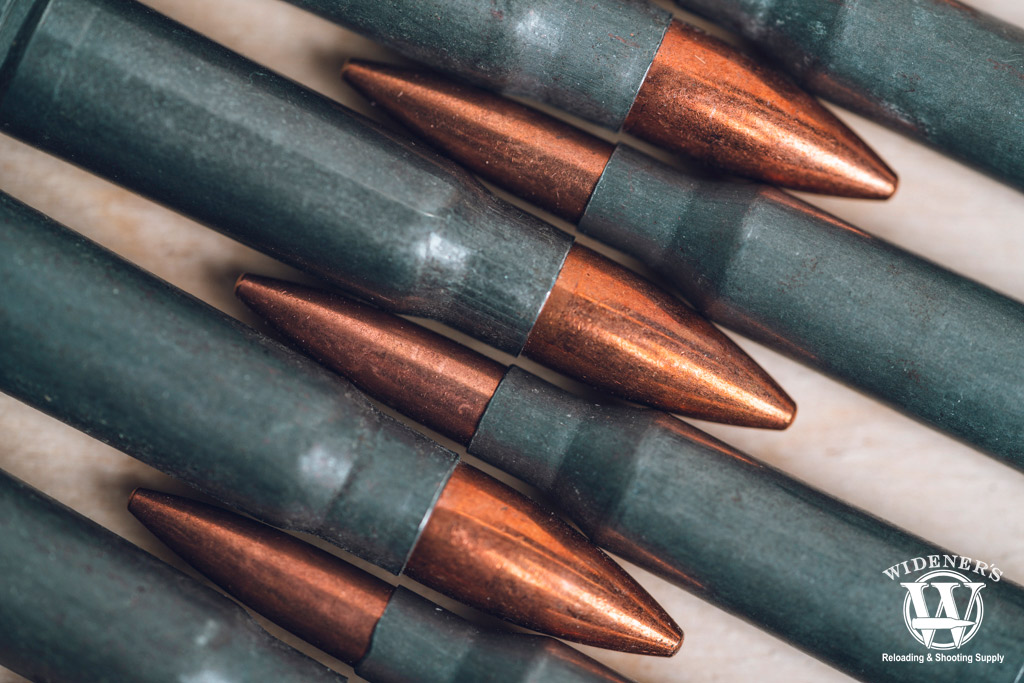
The beefy 7.62×39 (Left) is much larger in diameter than the thinner 5.45×39 bullet (Right).
If we’re talking military cartridges, the 7.62x39mm could be a distant relative of the 7.62×51 NATO round. It lacks the size and power of the larger NATO round but retains its .30 caliber characteristics on the battlefield. The 5.45x39mm on the other hand is more similar to the 5.56×45 NATO cartridge. It’s a zippy bullet that tends to tumble at distances before hitting its intended target.
The 7.62 is a heavier bullet and it carries more punch, or energy when hitting targets. The 5.45 on the other hand shoots flatter and has the velocity and range required for modern military applications. That’s not to say it’s a do-all cartridge, but its size does allow soldiers to carry more rounds, which is a plus on the battlefield.
We see these characteristics reinforced by looking at the data in the chart below.
| Caliber | Bullet Type | Bullet Weight | Velocity (Muzzle) | Energy (Muzzle) | 100 Yards (Velocity/Energy) | 200 Yards (Velocity/Energy) | 300 Yards (Velocity/Energy) |
|---|---|---|---|---|---|---|---|
| 7.62×39 | FMJ | 124gr | 2,350 FPS | 1,520 FT LBS | 2,078 FPS/1,189 FT LBS | 1,824 FPS/916 FT LBS | 1,595 FPS/701 FT LBS |
| 5.45X39 | FMJ | 60gr | 2,622 FPS | 1,060 FT LBS | 2,332 FPS/724 FT LBS | 2,002 FPS/534 FT LBS | 1,722 FPS/395 FT LBS |
AK-47 Ballistics
A quick look at the numbers of Federal Premium’s American Eagle 7.62x39mm load illustrates the shortfalls. With a 124-grain FMJ bullet and 200-yard zero, the drop at 500 is 87.5 inches. The energy at those distances comes in at 916 ft./lbs. and 412, respectively.
Then in 1957, the U.S. Military officially adopted the 7.62 NATO (7.62×51 mm) cartridge and began fielding M14s to chamber it. Compared to the Soviet load, the performance probably caught the attention of a few Soviet Generals.
The lightest American Eagle load currently available is a 149-grain FMJ. Again, with a 200-yard zero, the drop at 500 yards is 48 inches—not quite half of what the Red Army was experiencing, but close. The difference in energy delivered at those distances is also significant. They come in at 1,907 and 1,167 ft./lbs., respectively, nearly three times the punch at 500 yards.
The British military had already adopted the FN FAL, chambered for the same cartridge several years before. Despite the fact more NATO nations fielded it, the Red Army remained firmly entrenched in 7.62x39mm. Soviet official production of the original, albeit milled-receiver AK-47 halted in 1957, although there’s no shortage of other variants still in production, including some made in the United States.
Admittedly, the above figures are from today’s commercially available loads and not identical to those fielded by either military 50 years ago—or the same barrel lengths. They do, however, illustrate the difference in performance is significant.
The rate of fire in the original AK-47 came in at 40 rounds a minute in semi-auto, with full-auto coming in at a theoretical 600 rounds. Good luck swapping magazines at that rate.
AK-74 Ballistics
Federal doesn’t currently list a 5.45x39mm cartridge, but Hornady does. The company’s Black load wears a 60-grain V-Max bullet. It’s a screamer, coming out of the company’s test barrel—likely different than Federal’s standard—at 2,810 FPS. With a 200-yard zero, the drop at 500 is only 58.8 inches. The energy at that distance is 282 ft./lbs.
Wolf also makes an interesting 5.45x39mm load. Their Military Classic is a 60gr FMJ round that is a few grains heavier than true Russian 7N10 ammo. They state that it leaves the muzzle at 2,622 FPS but many reviewers have noted that it likes to hang out in the 2,800+ FPS range from a good 16-inch barrel. Those numbers put it more in line with the performance of the Russian 7N10.
The velocities recorded give it a slight advantage over the 5.56 NATO cartridge cited above. The margin is so slim that only an expert marksman would likely witness a difference in the field. However, when compared to the 7.62x39mm, we can see its advantages for hitting targets at long distances.
Kalashnikov: The Man Behind the Gun
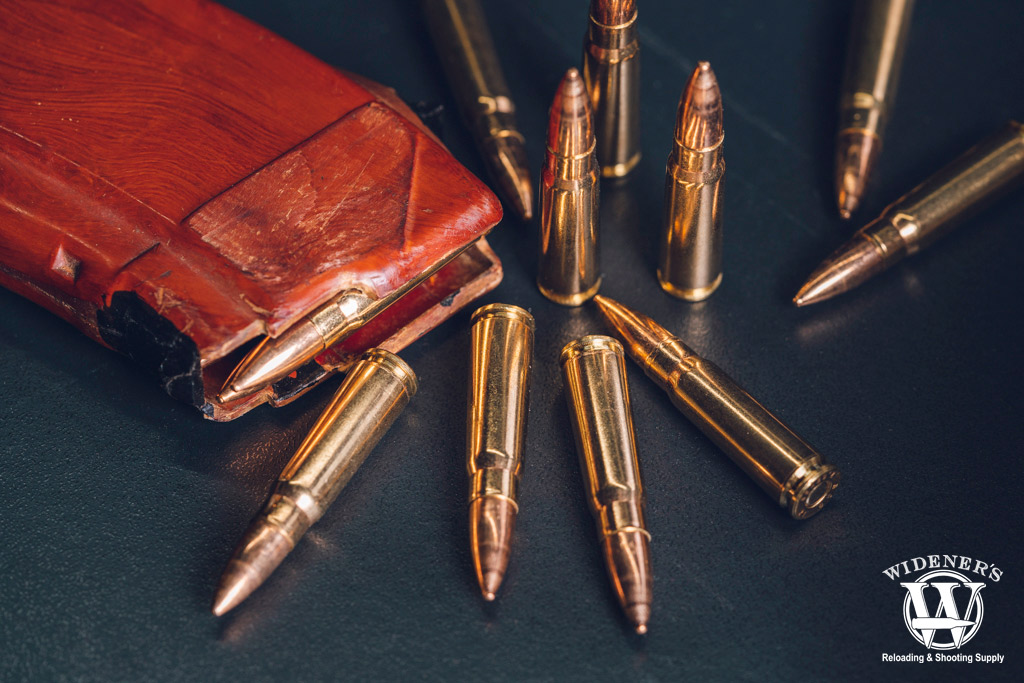
Kalashnikov designed his AK-47 battle rifle around the 7.62×39 Soviet rifle cartridge.
Mikhail Kalashnikov was born in 1919 when Russia was in a turbulent time in its history. The Bolsheviks won the October Revolution and were about to embark on a program of confiscating land and property from the nation’s wealthy and redistribution for the “common good.”
In 1930 the Kalashnikov family became one of the victims. Officials claimed many of their possessions and forced them to relocate to another region 600 miles away. Assigned a small tract to farm, in an area considered less than agriculturally ideal, it was tough for Mikhail and his 18 siblings.
Despite the hardship, he continued in school. There, his keen interest in everything mechanical began to take hold. Before entering the eighth grade, and with his stepfather’s permission, he left that meager existence and returned to the area he once called home. There he secured a job as a tractor mechanic, and before long the authorities noted his knowledge and transferred him to a plant that designed firearms. There his primary duty was testing rifle stock fitment.
In The Thick Of It
Then in 1938, when World War II was on the horizon, Kalashnikov became one of the many Red Army conscripts. His assignment was initially as a tank mechanic. He became commander of a T-34 tank after promotion to sergeant.
A combat wound in October 1941 sent him back to a hospital to recover, where conversations on the underperformance of Soviet small arms were chronic. His experience hunting and mechanical knowledge were about to pay big dividends.
Twelve months later, despite no formal engineering training, he worked on small arms for the Red Army. In 1943 the Soviet Union introduced the 7.62x39mm cartridge, and by 1944, Kalashnikov had an AK design to chamber it.
In military trials, it lost out to the SKS. Undeterred and more in tune with his modest upbringing and Soviet military budget, he tweaked the design to trim production costs. By 1947 he created a long-stroke piston-driven model with simplified fire controls and a stamped, one-piece receiver instead of a separate upper and lower.
Birth Of The AK-47
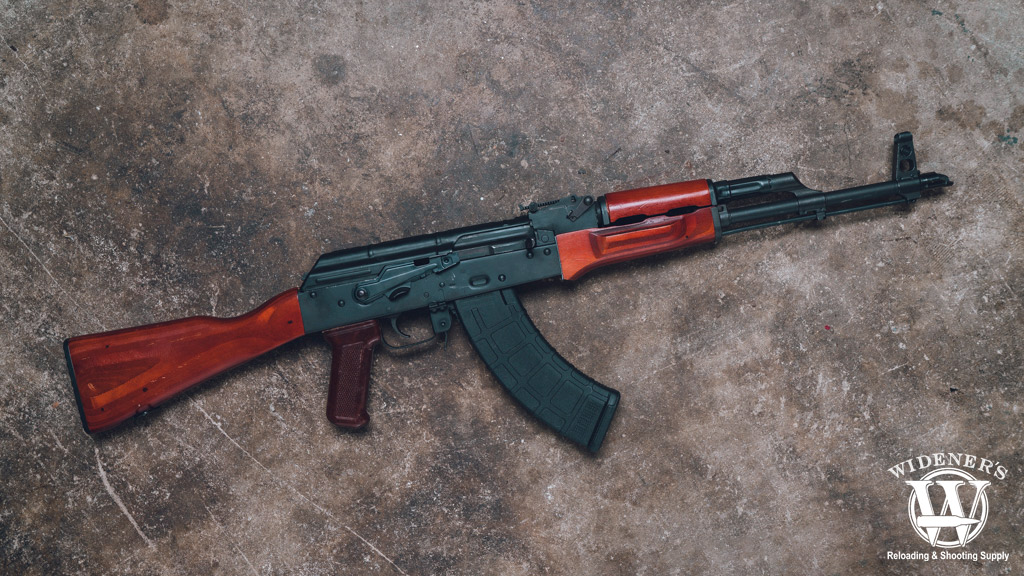
It’s hard to beat the original. Since 1947, over 75 million AK-47s have been produced by more than twenty different countries.
Official adoption by the Soviet military didn’t take place until 1949, although it’s permanently cemented in firearm history as the AK-47. This select fire measured 35 inches long and wore a 16.3-inch barrel. A folding version came in at a compact 25.4 inches with the stock collapsed and 34.4 when extended. Bayonets weren’t an option until 1955.
Other specifications included a weight of 7.7 pounds without the 30-round, double-stack magazine inserted. A cleaning kit stores away nicely in the wood stock.
By 1951, the Red Army fielded milled-receiver versions and was content with the firearm’s performance. However, the cartridge’s ability to deliver precision was likely a growing concern.
Ol’ Faithful?
That’s not to say the original AK was prone to stoppages. You’d be hard-pressed to find a Vietnam veteran who claimed the enemy couldn’t lay down effective fire because the AK-47 was prone to jamming. The weather-beaten and abused specimens fielded by Taliban forces years later reinforce that fact.
Regardless of neglect, both rifles deliver enviable reliability. It’s a genetic characteristic that makes them an ideal platform for inhospitable environments.
They are also faster and less expensive to manufacture than most other firearms. More AK-47s and variants, including the AK-74, have been made than any other gun in history. Estimates vary widely – due to the number of countries and factories that make or made clones – but somewhere between 40 to 150 million have rolled out of factories across the globe.
AK-47 VS AK-74: Thinner Is Better?

AK-47 VS AK-74: The AK-74 (Left), replaced the AK-47 (Right) as the Soviet battle rifle in 1974.
Despite the fact the U.S. military had recently adopted the M14, the jungle warfare in Vietnam forced it to rethink the heavier-recoiling cartridge. The M16A1 phased into duty in 1967, along with the 5.56 NATO ammo cartridge it chambered.
That thinner, lighter bullet brought roughly an additional 800 fps over the muzzle velocity of the 7.62x39mm. That meant a flatter trajectory, something the AK-47 was short on. Again, using American Eagle loads for an apples-to-apples comparison, with a 200-yard zero and 55-grain bullet drop is 50.3 inches at 500 yards. The Soviet cartridge and heavier bullet, however, win the energy race at both distances by a significant margin.
The debate about whether the U.S. made the right choice will likely run forever. There is, however, one odd endorsement that the decision was the right one. The Soviet Union officially retired the AK-47 in 1974, replacing it with the AK-74 and the 5.45x39mm cartridge it chambers.
The AK-74 is built entirely from the AK-47 with significant performance-improving differences. Although it still wears the Kalashnikov label, his role was a supervisory one, overseeing the legwork done by the A.D. Kryakushin group.
The Story of Alexei D. Kryakushin
How Kryakushin came to work on the AK-74 is an interesting tale. His path to firearm design is an untraditional one.
Kryakushin’s father worked in an armory in 1941, where he assembled firearms for the Red Army. Officials considered all factory workers there essential for the war effort, and release from those duties took special permission.
Meanwhile, his family, many miles away, was having trouble growing enough food to survive. Officials denied each of his multiple requests to leave and help his loved ones. The situation grew worse, and he exercised a painful solution. He paid off factory officials and agreed to have his son, Alexei, take his place on the assembly line.
Back On The Front Lines
In 1943, the Nazis were on the outskirts of Leningrad, Stalingrad, and Moscow. Despite the agreement, the Red Army forced his father into duty. He died in combat later that year.
Later, as the tides of World War II changed, the opportunity to study firearm manufacturing at a nearby college became available to Kryakushin. He jumped at the chance and agreed to attend night courses to fulfill his 8-hour-a-day duties at the factory.
He graduated in 1949, the same year the Soviets officially adopted the AK-47. Kryakushin then became part of the factory’s design department, and the A.D. Kryakushin Group launched in 1955. was officially established. By 1967 he was chief of the entire design bureau.
He and his team worked closely with Kalashnikov during the effort. The first efforts are rumored to have been AK-47s rechambered and barreled for the 5.45x45mm cartridge.
By the early 1970s, they had made a variety of modifications to the gun, and in 1974 the Soviet military officially adopted the AK-74. It made its first combat appearance in Afghanistan when the Soviet Union invaded in 1979. By all accounts, it did yeoman’s work.
Rundown Of The AK-74
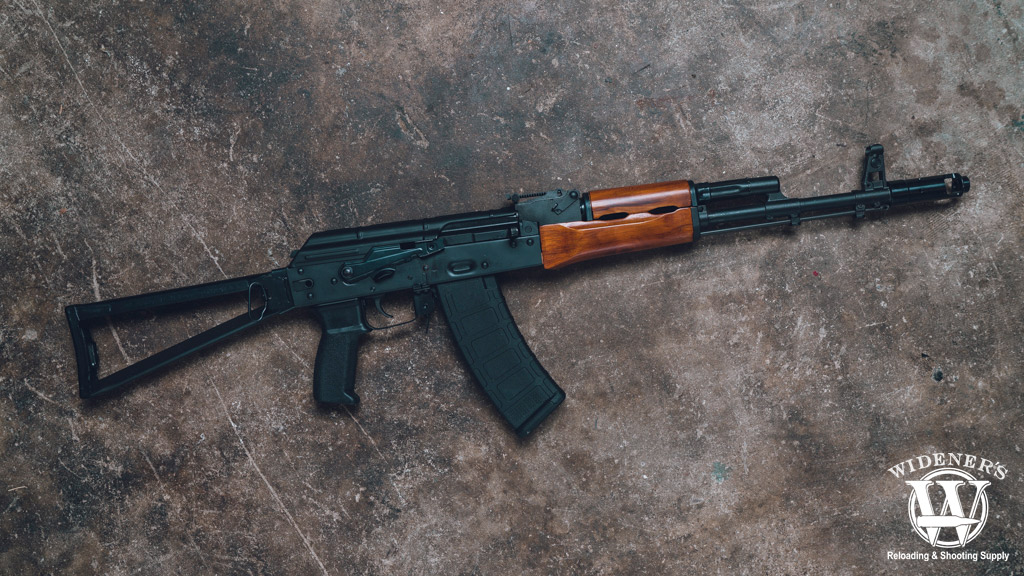
The AK-74 carries on the Kalashnikov tradition, with a few improvements at around 5 million rifles produced.
Roughly half of an AK-74’s parts are identical to those found in an AK-47. The commonality saves tooling time, avoids rendering entire parts warehouses worthless, and trims production costs. Like its predecessor, there is no gas valve.
One of the most significant changes in the long-stroke piston-driven gas gun is the extractor, which has a larger claw to improve reliability. The weapon also has a modified gas block, the ability to mount a 40-mm grenade launcher, and a threaded barrel for muzzle devices.
Basic Specs
The chamber and barrel – still 16.3 inches long—are resized to handle the 5.45x39mm cartridge. Chrome lining makes cleanup faster and reduces corrosion. The gun, sans magazine, tips the scales at 6.8 pounds – not quite a pound less than its AK-47 parent.
The magazine capacity remains 30 rounds. The overall length of the AK-74 is 37.1 inches, and early models wore laminated wood furniture. Later versions went to polymer in different military-specific colors during the 1980s.
It also has a bayonet mount, and calibration on the rear iron sight stretches out to 1,000 meters. The front post is elevation adjustable in the field, but windage changes require armorer aid.
Several AK-47 variants have appeared throughout the years, including the latest iteration carried by the Russian military, the AK-47M. It has a folding stock that gives the gun an overall length of either 37.1 or 27.6 inches. It weighs 7.5 pounds, again without a magazine.
The Russian military has adopted a variety of optic mounts – most of them to the side of the gun for CQB work. Standard versions, however, head to the front with iron sights and don’t wear anything as convenient as a rail.
Understanding Variants: AK-47 VS AK-74
How many AK variants are out there? It might be easier to number the stars in the sky. With more than twenty countries producing AKs over the years, there’s sure to be a variation to fit your palate. For practical purposes, we’ll only cover the models chambered in 7.62x39mm and 5.45x39mm.
| AK-47 Variant | Features | AK-74 Variant | Features |
|---|---|---|---|
| AKS-47 | Paratrooper, Underfolding Steel Stock | AKS-74 | Airborne, Side-Folding Steel Stock |
| AKM | Weighs Less, Improved Accuracy | AKS-74U | Compact, 8″ Barrel |
| AKMS | Airborne, Underfolding Steel Stock | AK-74M | Side Rail, Side-Folding Polymer Stock |
| RPK | Light Machine Gun, 24″ Barrel | RPK-74 | Light Machine Gun, 24″ Barrel |
| AK-103 | Polymer Furniture, Side Rail, Side-Folding Polymer Stock | AK-105 | Polymer Furniture, Side Rail, Side-Folding Polymer Stock, 12″ Barrel |
AK-47 VS AK-74: Winner?
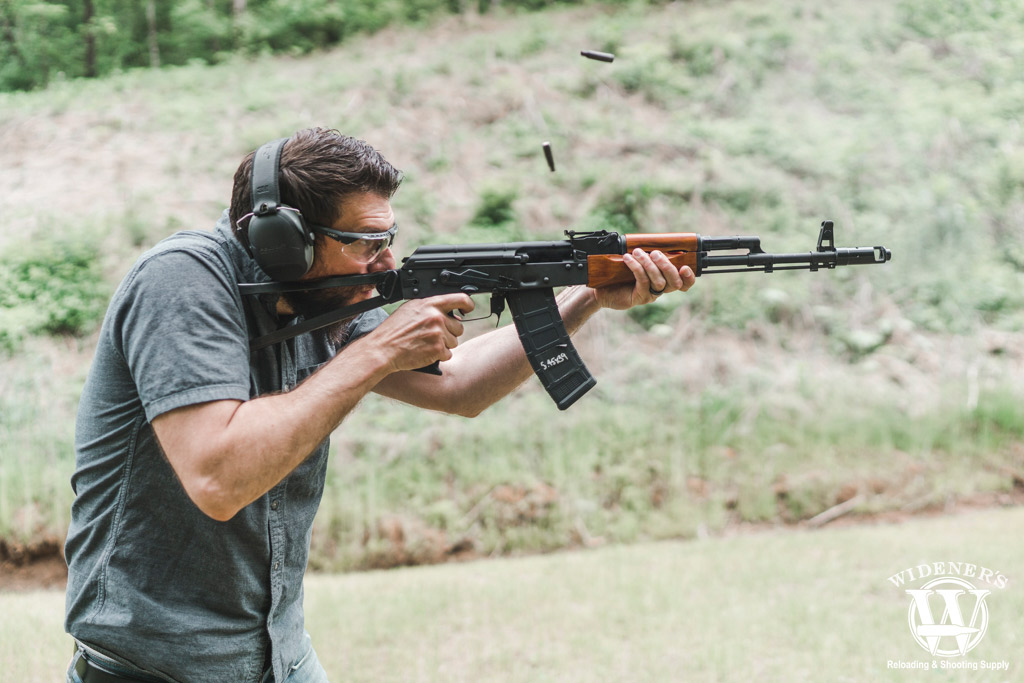
The AK-74 is a solid successor to the AK throne, but finding ammo to feed it can be a challenge.
Pitting the AK-47 VS AK-74 comes down to an ugly family feud. They share the same genetics and were built by or gently improved by men who understand hard times and how to make machinery capable of thriving through them. It’s tough to call which one comes out on top.
The ability to mount a grenade launcher on the AK platform is too endearing to ignore. The GP-25 and its advanced sighting system give both rifles the ability to launch grenades out to 400 yards. Nothing says “Nyet!” as loudly to an invading force as launching a 40mm projectile at their front line.
Strength In Numbers
If you’re in the market to buy, here are a few things to consider. The AK-47 has a lot more accessories widely available on the market. There’s no end to the number of customized Gucci AK’s on Instagram. If customizing an AK is a top priority to take care of your mission needs, then the AK-47 is likely your best option.
There are far more US-made AK-47 variants, however, more AK-74 options have been added in recent years. If you’re hoping to snag a Russian or Eastern-Bloc model, again, there are more AK-47 options. Consider the fact that more than 75 million AK-47s have been produced over the years versus only around 5 million AK-74s.
If the downrange trajectory is most important, the AK-74 comes out on top. Capacity is a tie, although, you can carry more 5.45x39mm in the same space versus 7.62x39mm. The rate of fire still belongs to the AK-47, assuming you’d ever want to buy a stamp and go full auto. Let’s be honest, looks matter. The AK-47’s appearance in Red Dawn outshined the AK-74 in Rambo 3.
The AK-74 comes out on top for its improvements and cartridge performance, though the victory needs an asterisk by it. The reason? Finding 5.45x39mm ammo can be a challenge, but inventories of 7.62x39mm are usually easy to find. Have to keep all those AKs fed, after all – and if you add that to your score sheet, the AK-47 remains king of the hill.


